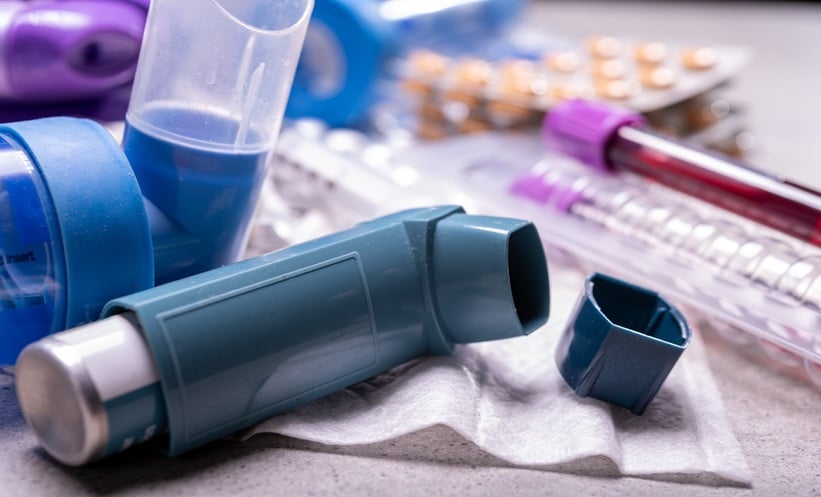Parent’s guide to labored breathing

When a child is struggling to breathe, it can be one of the most frightening experiences for a parent or caregiver. Labored breathing, known as respiratory distress, can develop quickly and may signal a serious underlying illness. Knowing what to look for, and when to seek care, can make all the difference in protecting your children.
“It’s important for parents and caregivers to know the signs of labored breathing, also known as respiratory distress,” says Kelsey Grimes, DO, outpatient pediatrician at OSF HealthCare. “This understanding can help them know when it’s time for their children to receive immediate medical attention.”
When to seek help
OSF HealthCare has multiple options to use if your child is in respiratory distress.
“During work-time hours, you can call your outpatient pediatrician’s office, or primary care provider’s office, and try to get a same-day appointment,” Dr. Grimes says. “In that, OSF also has a pediatric nurse triage line where a nurse can provide guidance or recommendations based on the symptoms you tell them. In the evenings, we have the pediatric after hours clinic (2806 Knoxville Ave. Peoria, Illinois), which is a good option.”
Additionally, OSF has multiple OSF OnCall Urgent Care and OSF PromptCare locations. But oftentimes if you’re concerned about breathing for your child, the OSF HealthCare Children’s Hospital of Illinois pediatric emergency department or calling 9-1-1 is the right first step.”
Why labored breathing happens
“If your child has labored breathing, oftentimes in the pediatric population, the most common cause is a viral infection. With viral infections you get a lot of inflammation, mucus, snot, phlegm – all of that,” Dr. Grimes says. “Kids’ airways are smaller. So, inflammation, even on the mild side, makes those airways even smaller. Then when they’re plugged up with mucus, or phlegm, they are going to really struggle to breathe.”
Children with significant breathing difficulty may need oxygen support to help them recover. This can be done using high-flow oxygen therapy (HFOT), which delivers air and oxygen down into their respiratory tract. In these cases, hospitalization is required.
At home, nasal saline and suction may be recommended, as well as controlling fevers with Tylenol or Motrin.
Rhinovirus, RSV (respiratory syncytial virus) and influenza, among other virus strains, are common culprits that can cause labored breathing. When treated properly, symptoms should begin to improve after three to four days. However, if symptoms worsen, it could indicate an underlying bacterial infection. This may require antibiotics or even hospitalization, depending on the child’s age and severity of illness.
Protecting kids from germs
“Regular hand hygiene and making sure when we touch surfaces (doorknobs, countertops, etc.) that we’re not rubbing our eyes or mouth after,” Dr. Grimes says. “Don’t share drinks or bites of food. Do anything you can do to try and prevent germ exposure. It’s hard, because a lot of these kids are in day care, preschool and kindergarten. So, there are no boundaries, and the kids are up close and personal there. You try your best for good hygiene, but in the end, they are probably going to be exposed.”
Signs of respiratory distress
Dr. Grimes says the most important thing to watch out for is how fast your child is breathing. Respiratory distress can cause a child to breathe much faster, or sometimes slower, than normal.
Retraction breathing, or the visible “sucking in” of the skin between or below the ribs, is another red flag.
“This happens because the muscle underlying the skin is really contracting, working hard to get that air in and back out,” Dr. Grimes explains.
Retraction breathing can happen under the rib cage (subcostal), between the ribs (intercostal), above the collarbones (supraclavicular) or at the base of the neck (tracheal tugging). Flaring nostrils are also a warning sign.
Other concerning symptoms include:
- Drooling in children who are past the teething stage
- Blue discoloration around the mouth
- Head bobbing with each breath (an emergency sign)
- Sitting forward and extending the neck in a “sniffing position” to ease breathing
- Wheezing when breathing out
- Grunting when exhaling
- Lethargic behavior (confused, drowsy)
Care and comfort at home
For viral infections, medical teams focus on supportive care, especially fever control.
For babies 2 months old or younger, any high or low temperature warrants an emergency department visit. Do not give Tylenol at this age.
Once babies are over 2 months old, Tylenol may be given in the appropriate dose based on weight, always under guidance from your pediatrician. Once over 6 months of age, babies can receive Motrin, as their kidneys are more developed. Both medications can be given every six hours as needed.
“When kids are having fevers, signs of labored breathing increase as well,” Dr. Grimes notes.
Hydration is also extremely important. “Really make sure to push fluids when your kids are sick. Hydration is key in recovery.”
Parents can help clear their child’s airway by using nasal saline followed by gentle suction. Humidifiers can help loosen mucus, and standing in a steamy bathroom with the shower running hot can offer short-term relief.
The bottom line
Labored breathing can be a sign of serious illness, and early action is the best protection. Parents and caregivers who recognize the warning signs and know when to call their pediatrician or seek emergency care, can help ensure their child receives timely, life-saving support.
Making sure your child receives the recommended childhood vaccines is another way to ensure your child is protected against respiratory illness.
link





